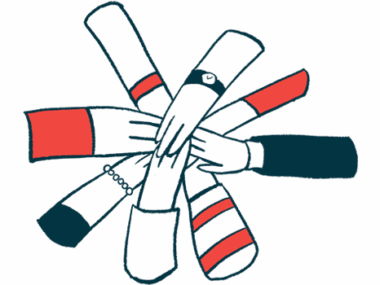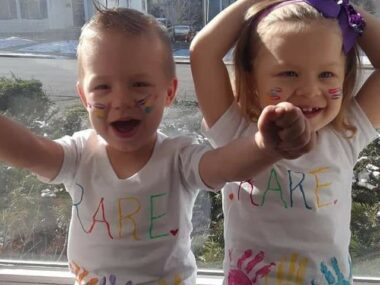Honoring this year’s Rare Disease Day any way we can
I take advantage of what's possible for me when I'm 'trapped in my body'
Written by |

Note: This column discusses an upcoming FDA-NIH Rare Disease Day event, which planned to bring together members of the rare disease community with healthcare providers, researchers, lawmakers, and more at the NIH main campus in Bethesda, Maryland. That event has since been postponed. Stay tuned for further announcements.
There’s a statement that keeps popping up on my social media. Sometimes it’s presented with a graphic showing an exhausted or sad character; other times, it’s just the text. Whatever the form, it gets around so much because it’s so relatable.
“I’m a person who wants to do a lot of things trapped in a body that doesn’t.”
I generally feel that sentiment all the time, but certain moments intensify it. Last week’s appointment with my neurologist was one of those triggers.
We started with the usual review of my symptoms, treatments, and other primary concerns. We discussed my sarcoidosis-associated small-fiber neuropathy and the possibility that I may have developed large-fiber neuropathy, as well — which may help explain my frequent falls. (I have more tests to come.)
Then we talked about my weight (and the 100-plus pounds I gained during my years on steroids) — which only exacerbates my problems, adding more stress to my joints and pressure on my heart and lungs. I know I need to lose weight. I want to lose weight. I even know how to lose weight. But it requires me to “do a lot of things,” as the statement I’ve quoted suggests.
I want to do what it takes to lose weight: to go food shopping weekly, plan and prepare healthy meals and snacks, go to the gym and exercise regularly. But my body, with its pain, fatigue, weakness, and shortness of breath, doesn’t. It’s a struggle I’ve been dealing with for years, and I’m always trying to find the balance between doing what I can and not beating myself up for not doing what I can’t.
Taking our opportunities
But this time of year, I want to “do a lot of [other] things,” too. Next Friday, Feb. 28, is Rare Disease Day, a commemorative day designated to raise awareness about rare diseases (including sarcoidosis, which I have) and the people who live with them. I want to do all I can to be a part of this movement and support the rest of my rare community, but my body, again, doesn’t.
I chose last year’s Rare Disease Day for the publication of my first book, “Kaleidoscope Rare Disease Stories,” featuring firsthand accounts from nearly 50 rare disease patients. To honor this anniversary, I’d hoped to set up a few book-signing events and perhaps do a few readings or speaking engagements with some of the other contributors. I wanted to join the National Organization for Rare Disorders for its State Advocacy Day. I wanted to find more local events to attend. But this body that I’m trapped in doesn’t want to do any of that right now, and I have to be OK with that.
Thankfully, the connections I’ve made through the rare disease community have offered me opportunities that are less physically taxing. This column itself has been a wonderful platform to share what I’ve learned and how I’ve found comfort through conferences and other awareness campaigns.
Bionews, the parent company of Sarcoidosis News, is an excellent resource and support, providing similar content for over 50 rare communities. Year-round, these sites offer disease-specific information, news, and patient and caregiver perspectives through columns and forums. For Rare Disease Day, it’s doing even more.
I’m honored and grateful to participate in the Keepin’ It Rare project, which explores how living with a rare disease can affect our mental health. This video series pairs members of the rare community with Al Freedman, PhD, to discuss the mental and emotional challenges that come with our diseases. As a psychologist and the father of someone with spinal muscular atrophy, “Dr. Al” offers a rare perspective to help us identify adaptive coping strategies.
Another notable event held each year is hosted by the U.S. Food and Drug Administration (FDA) and the National Center for Advancing Translational Sciences, part of the National Institutes of Health (NIH). FDA-NIH Rare Disease Day brings together members of the rare disease community with healthcare providers, researchers, lawmakers, and more at the NIH main campus in Bethesda, Maryland.
The two-day event, available for both in-person and virtual attendees, features panels, stories, scientific and artistic exhibits, and posters. As a member of Bionews’ Patient Advisory Board, I was able to co-author a poster, “Living Rare — In Our Own Words,” that will be presented there.
Far too many of us in the rare disease community feel “trapped in a body” that doesn’t allow us to do everything we’d like. But that doesn’t mean we can’t do anything. On Rare Disease Day and all year round, the real challenge is to find ways to raise our voices and insert ourselves into the conversation. We can attend an event virtually, read and share a relevant article, post a picture on social media — anything it takes to say “we are here.”
Note: Sarcoidosis News is strictly a news and information website about the disease. It does not provide medical advice, diagnosis, or treatment. This content is not intended to be a substitute for professional medical advice, diagnosis, or treatment. Always seek the advice of your physician or other qualified health provider with any questions you may have regarding a medical condition. Never disregard professional medical advice or delay in seeking it because of something you have read on this website. The opinions expressed in this column are not those of Sarcoidosis News or its parent company, Bionews, and are intended to spark discussion about issues pertaining to sarcoidosis.







Kim M
Hi Kerri,
I so enjoy all of your information and spirit!
I too, live with Sarcoidosis daily and just turned 65.
I am lucky to be able to still work, walk and stay active as much as I can.
It is tough to live with a disease no one knows about and can not be seen from looking at us.
We look so normal and healthy.
Keep writing and encouraging!
Kim
🦋 Kerry Wong
Hi Kim! Thank you for floating with me and sharing your story. It is difficult, but definitely helps to know that we're not alone.
~🦋